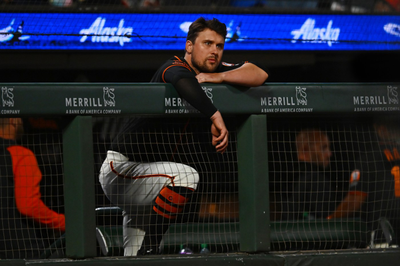
SAN FRANCISCO — It’s that time of year, Alex Cobb said Saturday night, after he took the loss in the Giants’ sixth defeat in their past seven games.
“It’s August,” he said. “Everybody’s trying to catch that second wind and sprint to the finish line.”
As their offensive slump approaches two months, and their grip on postseason position loosens, the Giants are looking for that second wind more than most.
They are still feeling the effects of a two-week stretch in the middle of June.
As they reeled off win after win during their hottest stretch of the season — a 10-game streak that ran their record 42-32 — more players than just Mitch Haniger suffered injuries that helped lead to the current derailment of their offense.
Haniger has just this week resumed hitting after fracturing his forearm on a hit-by-pitch in St. Louis on June 13. The two-week stretch also saw the losses of John Brebbia, who progressed to throwing bullpens this week, Luke Jackson and Wilmer Flores to the injured list.
But don’t overlook the players who avoided the IL.
J.D. Davis suffered a Grade 1 sprain in his ankle that he said Sunday lingered for a month after his unfortunate slide into third base in St. Louis.
Just a few days later, LaMonte Wade Jr.’s side/back tightness flared up for the first time, an issue that has since kept him unavailable off the bench in multiple games.
Wade, who continues to receive daily treatment on his midsection and frequently has is wrapped in athletic tape, said he wasn’t looking to make excuses.
“I just think it’s a long season,” he said. “The way the offense is going, I don’t think anybody is going to make any excuses and say it’s because of health. But health always does play a part in things. I think we’re just one good offensive game away from getting our momentum and keeping it going.”
Davis said that while the ankle affected his base running, his struggles at the plate had to do with multiple factors.
“On a scale of 1-10, it was probably like a 5-6 for about two weeks and then it came down a 1-2, where it wasn’t bothering me that much, just certain movements,” he said. “It has to do with more, (expletive), I don’t even know what to tell you. It had to do with running into tough pitching. A little bit of bad luck. A little bit of trying too much because of that luck. And on top of that, just going about it with the fatigue and the travel, not that it’s any excuses or anything like that.”
But the numbers are glaring.
The corner infield duo was playing so well that they were each gained mentions as potential first-time All-Stars, their surprise seasons carrying the Giants’ offense through the first two months of the season as much as anyone else.
Davis was batting .286 with a .846 OPS when he injured his ankle on June 13. Wade was at .280 with an .870 OPS — powered by a .415 on-base percentage that ranked among the best in the majors — when he was scratched with side tightness on June 20.
They were averaging a home run every 23.7 at-bats pre-injury versus one every 31.9 after.
In 44 games since, Davis is batting .188 with a .571 OPS; in 33 games for Wade, he is batting .238 with a .671 OPS with a more pedestrian .345 OBP.
“I think any time a player is feeling a little banged up, it’s going to compromise how good they can be on the field,” manager Gabe Kapler said. “If you go back to last year and years prior with Brandon Belt, if Brandon wasn’t feeling great, he wasn’t the best version of himself. You could probably say that for (Brandon Crawford) over the last couple years, as well.”
Wade, in particular, knows how compromising health problems can be. He never felt right last season after injuring his knee in spring training.
While the back/side tightness is an ongoing issue, he said it hasn’t affected him to the same degree.
“I think it’s night and day different,” Wade said. “The other stuff is just lingering stuff, wear and tear from the season. I’m not too concerned.”
As Kapler was quick to note, all 30 teams feel the toll of a 162-game season.
But not all must manage it while staring down an upcoming schedule that features the Tampa Bay Rays (71-48), Philadelphia Phillies (65-53) and Atlanta Braves (75-41) — twice.
Their recent skid has put their postseason standing in more precarious position, trailing the Phillies by 3½ games and holding no more than a 1½-game lead over the Cubs, Marlins and Reds in the wild card race.
“If we have this group out there for the rest of the season, we’re going to score a lot of runs,” Kapler said. “Michael Conforto’s going to go throuhg his good stretch; Joc Pederson’s going to go through his; (Mike Yastrzemski) will go through his; (Austin Slater) will come back around against left-handed pitching.
“All that stuff is going to happen if we can figure out a way to stay healthy and on the field. That’s the best way for us to succeed over the final six, seven weeks of the season.”